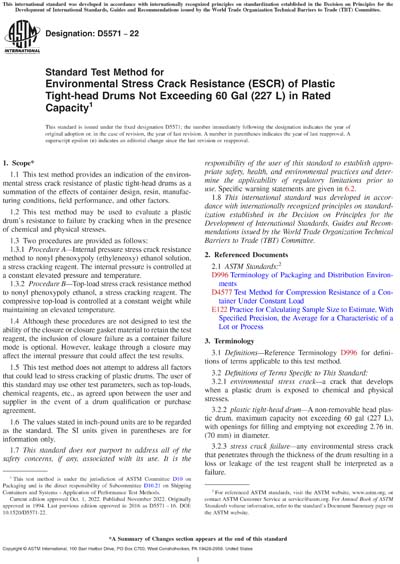Most recent
ASTM D5571-22
Standard Test Method for Environmental Stress Crack Resistance (ESCR) of Plastic Tight-head Drums Not Exceeding 60 Gal (227 L) in Rated Capacity
1.1This test method provides an indication of the environmental stress crack resistance of plastic tight-head drums as a summation of the effects of container design, resin, manufacturing conditions, field performance, and other factors.
1.2This test method may be used to evaluate a plastic drum's resistance to failure by cracking when in the presence of chemical and physical stresses.
1.3Two procedures are provided as follows:
1.3.1Procedure A - Internal pressure stress crack resistance method to nonyl phenoxypoly (ethyleneoxy) ethanol solution, a stress cracking reagent. The internal pressure is controlled at a constant elevated pressure and temperature.
1.3.2Procedure B - Top-load stress crack resistance method to nonyl phenoxypoly ethanol, a stress cracking reagent. The compressive top-load is controlled at a constant weight while maintaining an elevated temperature.
1.4Although these procedures are not designed to test the ability of the closure or closure gasket material to retain the test reagent, the inclusion of closure failure as a container failure mode is optional. However, leakage through a closure may affect the internal pressure that could affect the test results.
1.5This test method does not attempt to address all factors that could lead to stress cracking of plastic drums. The user of this standard may use other test parameters, such as top-loads, chemical reagents, etc., as agreed upon between the user and supplier in the event of a drum qualification or purchase agreement.
1.6The values stated in inch-pound units are to be regarded as the standard. The SI units given in parentheses are for information only.
1.7This standard does not purport to address all of the safety concerns, if any, associated with its use. It is the responsibility of the user of this standard to establish appropriate safety, health, and environmental practices and determine the applicability of regulatory limitations prior to use. Specific warning statements are given in 6.2.
1.8This international standard was developed in accordance with internationally recognized principles on standardization established in the Decision on Principles for the Development of International Standards, Guides and Recommendations issued by the World Trade Organization Technical Barriers to Trade (TBT) Committee.
ASTM International [astm]

